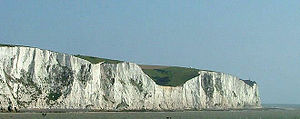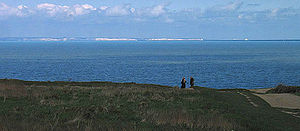- White Cliffs of Dover
-
This article is about the geographical feature. For other uses, see White Cliffs of Dover (disambiguation).
Coordinates: 51°08′N 1°22′E / 51.14°N 1.37°E
The cliffs seen across the channel from Cap Gris Nez, France
The White Cliffs of Dover are cliffs which form part of the British coastline facing the Strait of Dover and France. The cliffs are part of the North Downs formation. The cliff face, which reaches up to 107 metres (351 ft),[1] owes its striking façade to its composition of chalk accentuated by streaks of black flint. The cliffs spread east and west from the town of Dover in the county of Kent, an ancient and still important English port.
The cliffs have great symbolic value for Britain because they face towards Continental Europe across the narrowest part of the English Channel, where invasions have historically threatened and against which the cliffs form a symbolic guard. Because crossing at Dover was the primary route to the continent before air travel, the white line of cliffs also formed the first or last sight of the UK for travellers.
Contents
Location
The cliffs are located along the coastline between approximately: Latitude 51°06'N, Longitude 1°14'E and Latitude 51°12'N, Longitude 1°24'E. Shakespeare Cliff marks the point where Great Britain most closely approaches continental Europe. On a clear day, the cliffs are easily visible from the French coast.
Geology
The cliffs are composed mainly of soft, white chalk with a very fine-grained texture, composed primarily of coccoliths, plates of calcium carbonate formed by coccolithophores, single-celled planktonic algae whose skeletal remains sank to the bottom of the ocean and, together with the remains of bottom-living creatures, formed sediments. Flint and quartz are also found in the chalk.[2]
White cliffs like those of Dover are also found on the Danish islands of Møn and Langeland or the coasts of the island of Rügen in Germany. The cliff face continues to weather at an average rate of 1 centimetre (0.39 in) per year, although occasionally large pieces will fall. This most recently occurred in 2001, when a large chunk of the edge, as large as a football pitch, fell into the channel. Visitors are, therefore, urged to remain well away from the cliff edge.[3]
Ecology
Several species of cliff nesting birds nest on the cliff face, including fulmar and colonies of Black-legged Kittiwake. However, contrary to the words of the famous song ("There'll be bluebirds over the white cliffs of Dover"), bluebirds are an American species not found in the UK.
In popular culture
Film and television
- 28 days before it was released, a biohazard sign was projected on the cliffs to promote the 2007 film 28 Weeks Later.[4]
- In the 1991 film Robin Hood Prince of Thieves, starring Kevin Costner, the cliffs are the landing point of Robin of Locksley's water craft; a welcoming sign of home for the returning prisoner of war.
Literature and publications
- In Matthew Arnold's 1867 poem "Dover Beach", the cliffs are a sign of reassuring strength.
- Rudyard Kipling's 1902 poem, "The Broken Men", ends with the lines, "How stands the old Lord Warden? Are Dover's cliffs still white?", to represent the English exiles' homesickness.
- In Ian Fleming's third James Bond novel, Moonraker, a chapter is set at the cliffs. The villain attempts to assassinate Bond and Gala Brand by bombing the cliff so they are showered in debris.
- Jamaica Kincaid references the white cliffs of Dover in her essay, "On Seeing England for the First Time."[5]
- Other poetry includes Alice Duer Miller's "The White Cliffs", on which the 1944 film The White Cliffs of Dover was based.
- In a 2005 poll of Radio Times readers, the cliffs were named as the third greatest natural wonder in Britain.
- In Shakespeare's King Lear, Gloucester, blinded and despairing, asks to be led to the edge of the cliffs of Dover. He wants to commit suicide by leaping over the edge. His disguised son, Edgar, tells him that he is at the edge when they are nowhere near it, and, once Gloucester steps forward and falls down, Edgar tells his father that he has miraculously survived a fall from the top of the cliffs onto the beach. Confused at first but eventually believing him, Gloucester swears he will not consider suicide again.
Music
- The cliffs were referenced in the popular World War II song "(There'll Be Bluebirds Over) The White Cliffs of Dover". The song was originally performed by Vera Lynn and has been covered by many artists.
- On the album Parklife by Blur, the cliffs are the subject of the song "Clover Over Dover".
- The cliffs were referenced in the song, "Many Rivers to Cross" by reggae artist Jimmy Cliff. The song was featured on the album The Harder They Come, which was a soundtrack for the film of the same name.
- On the 2005 album Picaresque by the Decemberists, the cliffs are the setting for a suicide pact in the ballad "We Both Go Down Together".
- In 2010, girl group Girls Can't Catch filmed their music video for "Echo" on top of the cliffs.[6]
- Grammy Award-winning guitarist Eric Johnson's critically acclaimed, platinum-selling 1990 recording, Ah Via Musicom, produced the single "Cliffs of Dover (song)", for which Johnson won the 1991 Grammy Award for Best Rock Instrumental Performance.
- The cliffs were referenced in the song, "Like A Ship", by the group Traveling Wilburys. The song was featured on the album Traveling Wilburys Box Set.
See also
- Albion
- Beachy Head
- Dover, New Jersey
- "On a piece of chalk" by Thomas Henry Huxley
- Samphire Hoe Country Park...
- Seven Sisters, Sussex
Notes
- ^ "Coastal walk – White Cliffs of Dover, South-East Kent". The National Trust. http://www.nationaltrust.org.uk/main/w-coastal_walk-white_cliffs_dover.pdf.
- ^ Harris, C.S.. "Chalk facts". Geology Shop. http://www.geologyshop.co.uk/chalk.htm.
- ^ Beard, Matthew (February 1, 2001). "White cliffs of Dover go crashing into the Channel". The Independent. http://www.independent.co.uk/news/uk/this-britain/white-cliffs-of-dover-go-crashing-into-the-channel-705291.html. Retrieved 2010-04-18.
- ^ "'Biohazard' image on Dover cliffs". BBC News. April 13, 2007. http://news.bbc.co.uk/1/hi/england/kent/6553503.stm. Retrieved 2007-05-04.
- ^ Johnson, Matthew (2000). "The Dispossessed". New York University. http://www.nyu.edu/cas/ewp/html/johnson2000.html.
- ^ "Girls Can't Catch - Echo (OFFICIAL VIDEO)". YouTube. December 3, 2009. http://www.youtube.com/watch?v=49-Ongyqjdc.
External links
Categories:- Cliffs of England
- Geography of Kent
- Geology of England
- Port of Dover, Kent
- Unreferenced Kent-related articles
- Visitor attractions in Kent
Wikimedia Foundation. 2010.






